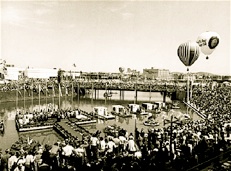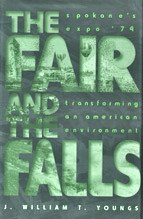On May 28th, 2009, people gathered at Spokane Falls to celebrate a historic settlement restoring water to the Waterfalls. For a slide show of that event, click here.
Dr. William Youngs, chair of the History Department, Eastern Washington University, and author of The Fair and The Falls: Spokane’s Expo ’74 - Transforming an American Environment, wrote the following statement spoken at the Waterfalls Celebration:
__________________
Comments on Spokane Falls
Bill Youngs
May 28, 2008
During the spring of 1873, almost exactly 136 years ago, James Glover - the founder of Spokane - was traveling through the Inland Northwest looking for a place to establish a town and make a fortune.
After journeying from Lewiston by horseback for several days through the lightly settled Inland Northwest he came to Spokane Falls. Glover knew at once that this was the place to build a town. He knew that a waterfall was the ideal source of power to grind grain and mill timber.
Glover also recognized that the falls were a thing of beauty. Later in life he remembered sitting beside the river on a rock during his first morning in Spokane. "I was enchanted," he wrote, "- overwhelmed - with the beauty and grandeur of everything I saw. It lay just as nature had made it, with nothing to mar its virgin glory."
A century later, stumbling upon the falls, he might have "held that thought" and proposed that the falls be set aside as a National Park. (One of the early visitors to Yellowstone, by the way, thought that Spokane Falls and its environs were even more beautiful than the nation's first national park.)
But James Glover grew up in the age of robber barons, industrial tycoons, and city-builders. Setting aside his realization of the beauty of the falls, he saw dollar signs rather than natural beauty, and said of the setting, "I determined that I would possess it."
And "possess" the falls and exploit the falls is exactly what Spokanites did for the better part of a century. For a brief time the frontier town was a trout-fishing mecca and sportsmen came from far away to stay in little hotels by the falls and fish. The first environmental debate in Spokane erupted during the 1880s when sportsmen alleged (correctly) that sawdust from the lumber mills, newly built along the falls, was harming the trout and the profitable fishing business. For a brief period the courts sided with the sportsmen and closed the mills.
But a few years later the mills had overwhelmed the falls, along with bridges, railroads, and highways. By the mid-twentieth century Spokane had all but forgotten the falls. There was even talk of paving over the south channel of the river past Havermale Island to provide more downtown parking!
What happened next was one of the great triumphs for environmentalism and urban renewal in American history. Under the leadership of one of the most effective proponents for urban renewal of our time, King Cole, the city overcame urban blight, built a notable downtown park, and held the first-ever environmental world's fair.
Just how important Spokane's Expo '74 is was revealed just a few weeks ago when Shanghai TV broadcast a four-hour special on the history of World's Fairs. The media giant sent four teams of to distant corners of the world to explore the significant fairs of the past. (Shanghai will have its own world's fair in 2010.) In the Shanghai TV production the viewer is led into an overview of environmentalism during the 1970s, including the first Earth Day and the Stockholm conference on the environment. Then the film segues to a ten-minute segment showcasing the history of our fair and the beauty of Spokane Falls today.
Sometimes we need visitors from afar to remind of us of the treasures in our own neighborhood. But since Expo, the city has pursued a generally positive approach to honoring and enhancing the falls with such improvements as the Centennial Trail.
The recent agreement with Avista to allow a constant flow of water through the falls is a huge new development in the story of the city and the falls. I deeply regret that I cannot be here in person to share this moment with all of you. But the reason for my absence underscores the importance of this moment: I am teaching this spring a course called, "The History of the American Wilderness." On Tuesday evenings I teach the class at Riverpoint, and on Thursday evenings I teach it at Eastern Washington University's program in Bellevue. A major theme in the class is the constantly evolving story of utility versus beauty in the history of the American environment.
We need both, don't we -- both beauty and bread, as John Muir once put it? And neither trumps the other. Speaking now as a teacher, I can tell you that this settlement has already worked its way into history curricula as a superb example of the way that we human beings can, with imagination, find ways to minister to our practical needs while honoring the natural beauty of our surroundings.
I cannot be with you in Spokane this evening, but just a few miles away in Bellevue I will be telling a new generation of college students the amazing story of Spokane's love affair with its falls!






